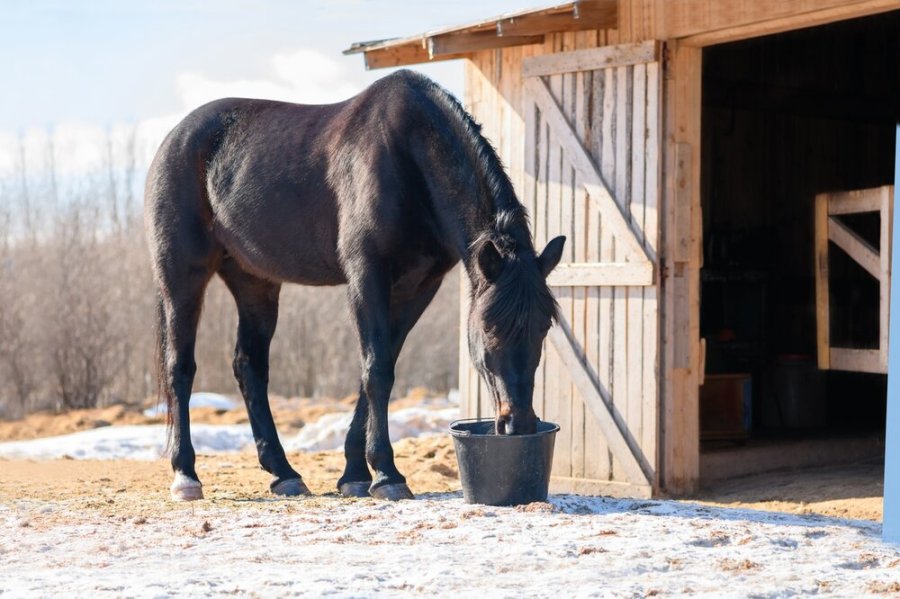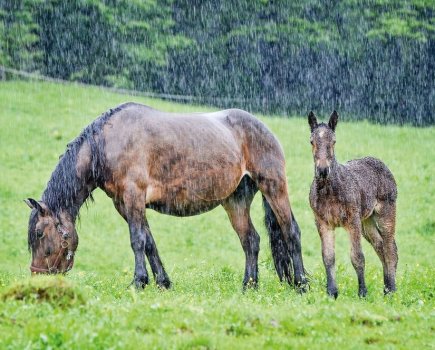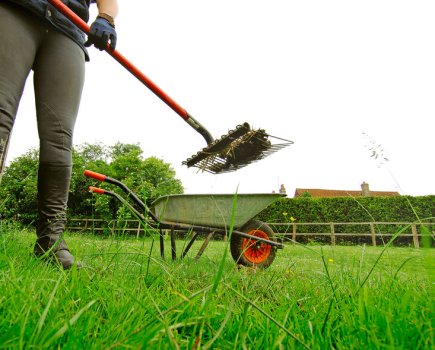There is a lot to consider when feeding a horse in winter. Feeding incorrectly can cause weight gain, poor condition, tricky behaviour and trigger major health problems, like colic. The golden rule is remembering that fibre is an essential part of a horse’s diet, all year round. To ensure your horse has enough fibre in their diet to keep their digestive system healthy, provide them with ad-lib hay or haylage. If weight gain is a concern, there are things you can do to make their fibre ration last longer and to reduce the amount of calories it provides.
Clare Barfoot RNutr, research and development manager at Spillers, explains what is good practice for winter feeding below.
It’s good to chew
Horses naturally graze for most of the day so to replicate this when stabled for long periods of time, provide your horse with a bucket of chaff with a few hidden succulents such as apples and carrots. Consider cafeteria-style feeding too. This will keep your horse occupied for longer, preventing the development of stable vices, stress and boredom, and even gastric ulcers.
As the temperature drops, remember that eating hay is a natural way of keeping your horse warm, because the process of digesting hay in the digestive tract produces heat. Chewing is also essential as it creates saliva, which is a buffer for stomach acid — the cause of gastric ulcers.
If turning your horse out in a field with several horses in and giving hay piles, make sure you place hay a good distance away from each other so that less dominant horses can still get their ration and the risk of one horse kicking another is lowered.
Keep them hydrated
Water is a key part of winter feeding because it is essential to keep your horse hydrated and help with their digestion no matter whether the temperature is cold or hot. Dehydration isn’t just a winter problem — it occurs in the winter too and is a major trigger for colic. Always ensure your horse has a constant supply of fresh water when they are stabled or turned out. In really chilly temperatures, regularly check troughs to see if they’re frozen, breaking the ice if needed and removing the ice with a sieve.
Adding a splash of hot water to buckets or something tasty like apple juice is a good way to encourage horses to drink in winter too. Bear in mind that not all horses are a fan of drinking very cold water, so doing little things like this to make drinking more appealing is important.
Feed a mash
To keep weight on older horses with fewer teeth or who have problems chewing course mix or dry cubes, try offering them soaked cubes made into a mash. You can try mixing it with water that’s had the chill taken off it (luke warm), so it makes a warm and hearty meal. Feeding a mash is also a great way of getting your horse to drink more, because it is made up with water.
Monitor weight gain
If your horse is a good doer, even in winter, they will still require the right nutrients and a balanced diet, so consider feeding a quality vitamin and mineral supplement added to a small amount of chaff to keep them healthy. Beware weight gain at this time of year — horses are designed to lose weight in winter — as it increases their risk of laminitis in the spring.
Just because the weather is colder, it doesn’t necessarily mean you should increase your horse’s concentrate ration. Use a weight tape and body condition score them regularly. Extra time standing in the stable, eating to stay occupied and doing less exercise to burn off those extra pounds can easily lead to weight gain over winter. To combat this, simply give your horse fewer calories and get them moving more.
Reduce the calorie content of his hay by soaking it, ideally for 16 hours (but definitely more than three hours), or try mixing some oat straw in with his hay ration to dilute it. To extend eating time, feed hay and haylage in a small-holed net. Switch calorie-laden hard feed for a low-calorie balancer mixed with a low calorie chaff.
Beware feeding starch
A diet that’s too high in starch, which is a form of instant energy, together with restricted winter turnout, means your horse will be buzzing with energy that they may not need. If your horse displays fizzy behaviour, switch to a diet that’s low in starch, but high in fibre. This will help to keep your horse in a calmer frame of mind and replicate the more natural, forage-based diet they have evolved to live on. This means giving them lots of hay, haylage and as much turnout as possible.
Watch the calories
A natural drop in the energy level of your horse’s main forage source, namely grass, together with the cold weather means they will have to use lots of calories to keep warm. Your horse’s energy requirements may increase by 30% or more in winter in order to maintain their body temperature.
Bear in mind that it’s perfectly normal for your horse to put on weight in spring and summer and then lose these extra pounds over winter and it should be encouraged. However, if your horse needs extra calories, make sure you’re feeding the recommended amount of feed — this will be stated on the feed bag. If you are, then consider adding a conditioning cube or mix, and give this alongside ad-lib, good quality forage and a high oil conditioning chaff.
Feed the correct amount
Most owners feed by the scoop but with all the different types of feed available one scoop can weigh considerably more or less than another. This is why it is really important to weigh your feed, even if you only do so once. The easiest way is to put one scoop of your chosen feed in a carrier bag and weigh it on your kitchen scales. Then all you need to work out is how many scoops of it you need to feed your horse per day.
Provide a balanced diet
Feeding a forage-only diet in winter can mean your horse might be missing out on the essential nutrients they need. If your horse is only eating grass and hay, or you’re not feeding the full recommended amount of a particular hard feed (see previous point), try giving them a broad spectrum vitamin and mineral supplement or low-calorie feed balancer to balance out any deficiencies. This should ensure the horse’s body has all it needs to fuel their extremities.
It’s important to feed a balanced diet all year round to support your horse’s long-term health and well-being. A diet that is unbalanced or deficient in certain nutrients could start to show with poor hoof or coat quality, a lack of muscle tone or a compromised immune system. If, like many, your horse doesn’t need extra calories in the form of a full ration of compound feed a balancer would be the best solution. These are specifically designed to complement forage or pasture based diets but without unwanted extra calories.
Get to the bottom of weight loss
It’s important to eliminate any clinical reasons for weight loss when feeding in winter. Next check that the quality of your forage is good and make sure that it is always fed ad-lib — even in the field. It is also worth making sure your horse is well rugged as significant calories can be used just to keep the body warm.
In terms of your horse’s bucket feed you should be feeding the recommended quantity, in meals of no more than 2kg so as to not overload the stomach. If your horse is still not maintaining weight increase the calorie density of the meals. Try a conditioning feed or if he has a sharp temperament opt for a fibre and oil based medium energy feed; these types of feed may not say ‘conditioning’ and may be packaged as competition feeds, nonetheless they will be medium energy and will help build condition.
Feeding a laminitic in winter
Obesity and diet are two key laminitis risk factors that are under your control. As grass is the largest contributor of water-soluble carbohydrate (sugars and fructans) it is important that it is restricted, even in the winter. Choose feeds that are high in fibre and low in sugar and starch.
If your horse is a good doer or needs to lose weight consider feeding a balancer designed to complement a calorie restricted diet. If he requires more condition opt for a high fibre feed suitable for horse and ponies prone to laminitis. It’s useful to have the nutritional value of your hay analysed and to soak it before feeding to reduce the water-soluble carbohydrate (WSC) content.
Love hacking? Join our free #Hack1000Miles challenge and see how far you can go!
Subscribe to Your Horse Magazine – the perfect Christmas gift!









